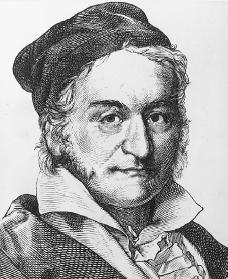
Gauss
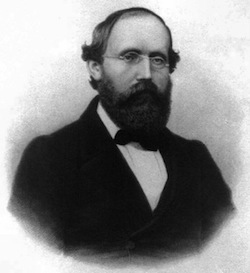
Riemann
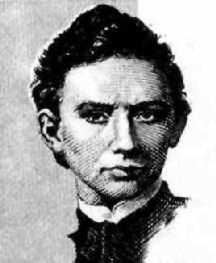
Bolyai
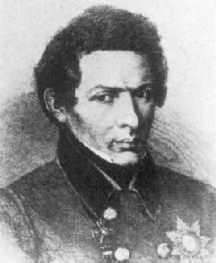
Lobachevsky
| HPS 0410 | Einstein for Everyone |
Back to main course page
John
D. Norton
Department of History and Philosophy of Science
University of Pittsburgh
We saw in the last chapter that the earlier centuries brought the nearly perfect geometry of Euclid to nineteenth century geometers. The one blemish was the artificiality of the fifth postulate. Unlike the other four postulates, the fifth postulate just did not look like a self-evident truth.
In the eighteenth century, as in the centuries before, the project had been to rid Euclid's geometry of this flaw. The goal was to derive the fifth postulate from the other four. Then, geometry would need only to posit the first four postulates; the fifth would be deduced from them.
An indirect strategy was used in the efforts to derive the fifth postulate from the other four. The procedure was to take the first four postulates and add the negation of the fifth to them. Then the geometer would proceed to explore the consequences of these five assumptions. The goal was to demonstrate that a contradiction followed.
| Euclid's
first four postulates |
and | the
negation of Euclid's fifth postulate |
leads to | a contradiction. |
Arriving at a contradiction would show that a false presumption had been made somewhere. The candidates for the false presumption were the five assumptions of the starting point. Four of these were just the first four of Euclid's postulates, which were taken to be secure. So the false presumption had to be the negation of the fifth postulate.
| Euclid's
first four postulates |
and | the
negation of Euclid's fifth postulate |
leads to | a contradiction. |
Conclude: This assumption must be false. |
That is, the finding of a contradiction showed that the negation of the fifth postulate was false. Stripping out the double negative ("...negation...false") we just have that the fifth postulate is true. Or, more carefully, as long as the first four postulates are true, then the fifth is true. And that just means that we have inferred the truth of the fifth postulate from the other four. The postulates needed for Euclid's geometry would thereby be reduced to the first four.
The work was both encouraging and maddening. It was encouraging in that all sorts of very odd results followed. It was maddening in that none of the results, no matter how odd, was actually a flat-out contradiction. None flatly asserted "A and not-A." It was as if the geometers had struggled past many dangers but were perpetually trapped one step short of the end of their journey.
In the nineteenth century, the reason for this frustrating failure was finally recognized by Gauss, Riemann, Bolyai, Lobachevsky and others. When the earlier geometers had posited an alternative to Euclid's fifth postulate, they were not creating a contradiction. Rather they were defining a new geometry.The conclusions they drew were merely facts in the new geometry. These facts seemed odd simply because they belonged in a geometry different from that of Euclid.
 Gauss |
 Riemann |
 Bolyai |
 Lobachevsky |
The import of this realization was profound. It gradually became clear that geometry did not have to be Euclidean. The success of Euclidean geometry was something to be discovered. It certainly worked where ever we looked. But would it still work if we surveyed volumes of space on the cosmic scale? And what are to we to make of Kant's assurance that space has to be Euclidean, a synthetic a priori fact?
If one has a prior background in Euclidean geometry, it takes a little while to be comfortable with the idea that space does not have to be Euclidean and that other geometries are quite possible. In this chapter, we will give an illustration of what it is like to do geometry in a space governed by an alternative to Euclid's fifth postulate.
One of most important by-products of the efforts to derive Euclid's fifth postulate were simpler, alternative formulations of the postulate that could be used in place of Euclid's original. Many were found, including:
• There exists a pair of coplanar straight lines,
everywhere equidistant from one another.
• There exists a pair of similar, non-congruent triangles.
• If in a quadrilateral a pair of opposite sides are equal and if the
angles adjacent to the third side are right angles, then the other two
angles are also right angles. (Saccheri)
• There is no upper bound to the area of a triangle.
Of all the reformulations, one proves to be most useful. It was stated by an 18th century mathematician and physicist, Playfair. His postulate, equivalent to Euclid's fifth, was:
5.ONE Through any given point can be drawn exactly one straight line parallel to a given line.
This formulation made it easy to state what the alternatives were. In
place of ONE, we could have NONE or MORE than one.
5MORE. Through any given point MORE than one straight line can be drawn parallel to a given line.
| The idea behind this alternative is easy to say but hard to draw The figure below shows its import. All the lines drawn through the point are straight and parallel to the line not passing through the point. The picture cannot really show that, of course, since the screen is a surface that conforms to Euclid's postulates. | And just what does "parallel" mean? Euclid tells
us: Definition 35. Parallel straight lines are such as are in the same plane, and which being produced ever so far both ways do not meet. |
The other possibility is:
5NONE. Through any given point NO straight lines can be drawn parallel to a given line.
Once again the import of the alternative postulate is hard to draw since the screen is a Euclidean surface. In the figure, the line through the point is a straight line. The postulate tells us that no matter which straight line we pick through the point, the outcome is the same. It is not parallel to the line not on the point. If extended it will eventually meet the other line.
Let us join the explorers of the nineteenth century and take the first steps into the new space of these odd geometries. Let us explore the space of 5NONE.
| To begin, select ANY STRAIGHT LINE at all in our space with two points A and B on it. At each of A and B, we will erect perpendicular, straight lines. | It will be important for what follows that the line selected be any straight line at all. However we shall see that the analysis below can only be carried out if the two points A and B are selected so that they are quite close together. |
| The alternative postulate, 5NONE,
assures us that these perpendiculars, if projected, will eventually
meet at some point. Let us call that point O. There is a perfect symmetry in the figure; we could switch A and B and nothing would change, so we can infer that AO = BO |
| Now find the midpoint of AB and call
it Q. Erect a perpendicular to AB at Q. Project it until it
eventually meets AO and BO. (It must meet them since there are no
parallels in this geometry.) Where will in meet them? It cannot be to either side of the point O since then there would be an asymmetry. The midpoint Q and its perpendicular do not favor either side. So the perpendicular must pass through the point O. What can we say about the length of OQ? In the figure, it looks as if OQ is shorter than OA. Of course little in the figure is really quite as it looks. Both OA and OB are straight lines, for example, but they look curved. It turns out that OA and OQ are the same length: OA = OQ To see this, just consider the triangle OAQ. It is constructed in exactly the same way as the triangle OAB; that is, we erect two perpendiculars and project them until they meet. So the triangle OAQ has the same symmetries that led us to conclude that OA=OB in triangle OAB. The same reasoning leads us conclude that OQ and OB are the same length. So: OA = OQ = OB |
| Now repeat
the construction. Bisect AQ and from that point erect a perpendicular that will pass through O. Bisect QB and from that point erect a perpendicular that will pass through O. By repeating this process indefinitely, we can divide the original interval AB into as many equal sized parts as we like. Perpendiculars raised from each of these points will all pass through the point O. As before, all these perpendiculars will have the same length. If we measure distance along these perpendiculars, we conclude that the point O is the same same distance from every point on the line AB. Clearly the point O has a special significance for the entire straight line through AB. Recall that every line in the figure to the right is a straight line! |
| Let us now do essentially
the same construction but in a way that extends past AB. As before, we have points A and B on the line we chose earlier with the two perpendiculars erected at A and B. On AB produced through B we pick a point C such that AB=BC. |
| We now erect a perpendicular at C. As before, it must intersect the perpendiculars at A and B at the same point O and the perpendiculars OA, OB and OC will have the same length OA = OB = OC The argument is essentially the same as before. If the perpendicular at C did not pass through O, it would intersect the perpendicular at A at some other point O' on AO. But that would now mean that the perpendicular at B no longer respects the symmetry in the large triangle AO'C. Continuing the same arguments above gives us the equality of the lengths of all the perpendiculars. |
This construction could be continued
with points D, E, F, ... each a distance AB advanced from the point
before. At each we erect a perpendicular, which will intersect the others
at the same point O. Since the triangles produced by this construction,
OAB, OBC, OCD, ODE and OEF are congruent, the angles at the apex are all
the same:
angle AOB = angle BOC = angle COD = angle DOE = angle EOF.
That is, by extending the base of the triangle, AB to AC to AD etc. we can make the angle at the apex grow as large as we like.
| In order to sustain this last result,
we need to exclude one possibility.
What if all these vertical straight lines do meet at the point O,
but they do it in such a way that the angles between them are zero?
That would not be something we would expect from our normal
Euclidean intuitions. However we are exploring a new geometry so we
should expect the unexpected. Were this to happen, the figure showing the construction would look something like the figure at the right. The perpendiculars erected at A, B, ..., G would all intersect at O tangentially, that is, with zero angle between them. The figure shows how the lines on either side of O form a symmetric configuration. The lines in the top of the figure will be just like those in the bottom half, but inverted. We have to have this symmetry since we should get the same results if we had started the construction with line A'G' and dropped the perpendiculars down the figure. All the lines in this figure are straight lines. They are: AOA', BOB', COC', DOD', EOE', FOF' and GOG' They do no look straight because they are lines of another geometry draw on a surface whose geometry is Euclidean. |
| If these perpendiculars did all meet
with zero angle between them, then the analysis that follows would
fail. Exactly what the new analysis would be is unclear to me now.
It might be that a geometry with this property may turn out to be
inconsistent. Or it may just be another strange geometry. I cannot
say without further specification of the other commitments of the
geometry. However we can say that it would be a geometry very different from the sorts of geometries we are used to. For a geometry with this property would violate Euclid's second postulate, as it is usually understood. That postulate assures us that we can always "... produce a finite straight line continuously in a straight line." The tacit assumption is that the line produced is unique. Certainly all the familiar Euclidean constructions that use the postulate assume the uniqueness of the line produced. This uniqueness fails in geometries with this zero angle property. Since all the lines meet at O with zero angle between them, a straight line in the bottom half of the figure can be produced by any of the straight lines in the top half. As the figure on the left shows, the straight line CO can be produced in multiple ways, as: COE', COD', COC', COB' Since we wish to avoid this sort of violation of Euclid's second postulate, we will exclude the possibility that the verticals meet at a zero angle. |
With this possibility excluded, we can return to the analysis with the assurance that the vertical lines in the construction meet at the apex O with a non-zero angles between them. This assurance provides a way for us to make the angle at the apex as big as a right angle. Let us say that this happens with a base AG. It does not stop here. We can keep extending the base to G' until we have a second right angle at GOG'. And we can extend to G" so that we have a third right angle at G'OG''. And finally we can extend the base to G''' so we have a fourth right angle at G''OG'''.
We have arrived at something remarkable in this figure. It is not just that all these lines are straight lines. It is more. The angle AOG''' is four right angles. How can that be? Rather than tell you right away, let me give you a clue. We don't need to draw all the lines as straight in the figure. We just need to remember which are straight--in this case all of them. So we can redraw the figure as:
Think once again what it means for the angle AOG''' to be four right angles. Consider the line OA as it sweeps around O. It passes one right angle to reach OG; two right angles to reach OG'; three right angles to reach OG''; four right angles to reach OG'''. But if a radial arms sweeps four right angles, it has returned to its starting point. That is, the line OG''' has returned to OA; that is OG''' is OA. Or the point G''' just is the same point as A. So the figure is more correctly drawn as:
Notice what has happened. We started with a straight line AB and extended it to G, G', G'' and then finally back to itself. So the straight line on which points A and B lie is actually a straight line that wraps back onto itself.
Now recall that there was nothing special about this line. We started with ANY STRAIGHT LINE at all. It follows that all straight lines in the new geometry wrap back onto themselves. Since these straight lines fill all of space, it follows that that this space wraps back onto itself in every direction.
This last figure has more surprises. To begin, recall that all the lines in it are straight. So it follows that one of the quarter wedges--AOG'' say--is actually a triangle, since it is a figure bounded by three straight lines. Moreover, the angles at each corner are the same--a right angle. That means that we have a triangle the sum of whose angles is three right angles, one more than we are used to for all triangles in Euclidean geometry.
Also it is clear from the symmetry of the three angles, that each side is the same length. This triangle is also an equilateral triangle. So it is more accurately drawn as the triangle on the right.
There is also a circle in the figure. While the line AGG'G''G''' is a straight line, it also has the important property of being the circumference of a circle centered on O. Every point on AGG'G''G''' is the same distance from O. That is the defining property of a circle.
And what an unusual circle it is. It has radius AO. That
radius AO is equal in length to each of the four segments AG, GG', G'G'',
G''A that make up the circumference.
Radius = AO
Circumference = AG + GG' + G'G'' + G''A
AO = AG = GG' = G'G'' = G''A
That means that the circle AGG'G''G''' has the curious property that
Circumference = 4 x Radius
Contrast that with the properties familiar to us from
circles in Euclidean geometry
Circumference = 2π x Radius
A longer analysis would tell us that the area of the circle AGG'G''G'''
stands in an unexpected relationship with the radius AO. Specifically
Area = (8/π) x Radius2
In Euclidean geometry, the area of a circle relates to its
radius by
Area = π x Radius2
Let us return to our starting point. Euclid's achievement appeared unshakeable to the mathematicians and philosophers of the eighteenth century. The great philosopher Immanuel Kant declared Euclid's geometry to be the repository of synthetic, a priori truths, that is propositions that were both about the world but could also be known true prior to any experience of the world. His ingenious means of justifying their privileged status came from his view about how we interact with what is really in the world. In our perceiving of the world, we impose an order and structure on what we perceive; one manifestation of that is geometry.
The discovery of new geometries in the nineteenth century showed that we ought not to be so certain that our geometry must be Euclidean. In the early twentieth century Einstein showed that our actual geometry was not Euclidean. So what are we to make of Kant's certainty? Einstein gave this diagnosis in his 1921 essay "Geometry and Experience."
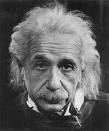 |
"... an enigma presents itself which in all ages
has agitated inquiring minds. How can it be that mathematics, being
after all a product of human thought which is independent of
experience, is so admirably appropriate to the objects of reality?
Is human reason, then, without experience, merely by taking thought,
able to fathom the properties of real things? In my opinion the answer to this question is, briefly, this: as far as the propositions of mathematics refer to reality, they are not certain; and as far as they are certain, they do not refer to reality..." |
To restate Einstein's point in terms closer to Kant's terminology:
• In so far as geometry is synthetic its propositions are not certain. That is, they are not a priori. They are empirical claims about the world to be investigated by science like any other claim. We can never be absolutely certain of them.
• In so far as a geometry's propositions are a priori, they are not factual claims about the world. That is, they are not synthetic. They are "if-then" statement of logic within some logical system whose initial propositions are the postulates of the geometry.
Let us return to the triangle we saw earlier.
Count the sides: 1, 2, 3. "A triangle has three sides." ... is analytic, since the definition of triangle includes the idea that it has three sides. |
A + B + C = 180 degrees = two right angles "A triangle's angles sum to 180 degrees." ... is synthetic, since this summation to 180 degrees is not part of the definition of a triangle. It is an addition. |
| This proposition is known a priori. That is, its truth is know to us prior to any experience of triangles. The definition of a triangle assures us every triangle we meet has three sides. If the figure does not have three sides, it is not a triangle. | However, contrary to Kant, we cannot know that the sum of the
angles of all triangles is 180 degrees prior to experience of
triangles in the real world. That is, we cannot know this a priori. Euclid's Elements does assure us that the sum is 180 degrees. However Euclid's geometry is one of many possible geometries. We cannot know a priori which is the geometry that applies to our world. We have to investigate the world to find out which applies. The proposition is a synthetic, a posteriori proposition. Worse, once Einstein had completed his general theory of relativity, the truth of the proposition on ordinary scales turned out to be only approximate and, on cosmic scales, it was likely false. |
Copyright John D. Norton. December 28,
2006, February 28, 2007; February 2, 9, 14, September 22, 2008; February
2, 2010. February 14, 2017. February 24, 2022.